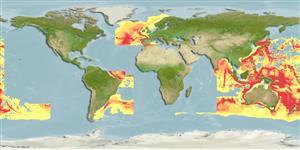Arcoscalpellum michelottianum (Seguenza, 1876)
| Native range | All suitable habitat | Point map | Year 2050 |

|
| This map was computer-generated and has not yet been reviewed. |
| Arcoscalpellum michelottianum AquaMaps Data sources: GBIF OBIS |
Google image |
No photo available for this species.
Classification / Names Common names | Synonyms | CoL | ITIS | WoRMS
Thecostraca | Scalpellomorpha | Scalpellidae
Environment: milieu / climate zone / depth range / distribution range Ecology
Sessile; depth range 64 - 5190 m (Ref. 7473). Temperate
Distribution Countries | FAO areas | Ecosystems | Occurrences | Introductions
Indo-West Pacific, Atlantic and the Mediterranean.
Length at first maturity / Size / Weight / Age
Maturity: Lm ? range ? - ? cm
Life cycle and mating behavior Maturity | Reproduction | Spawning | Eggs | Fecundity | Larvae
Main reference
References | Coordinator | Collaborators
Buhl-Mortensen, L. and J.T. Hoeg 2006 Reproduction and larval development in three scalpellid barnacles, Scalpellum scalpellum (Linnaeus, 1767), Ornatoscalpellum stroemii (M. Sars, 1859) and Arcoscalpellum michelottianum (Seguenza, 1876), Crustacea: Cirripedia: Thoracica) Thoracica): implications for reproduction and dispersal in the deep sea. Mar. Biol. 149:829-844. (Ref. 7473)
IUCN Red List Status
(Ref. 130435: Version 2025-1)
CITES status (Ref. 108899)
CMS (Ref. 116361)
Threat to humans
Human uses
| FishSource |
Tools
More information
Diet composition
Food consumption
Predators
Max. ages / sizes
Length-weight rel.
Length-length rel.
Length-frequencies
Mass conversion
Abundance
Internet sources
BHL | BOLD Systems | CISTI | DiscoverLife | FAO(Publication : search) | Fishipedia | GenBank (genome, nucleotide) | GloBI | Gomexsi | Google Books | Google Scholar | Google | PubMed | Tree of Life | Wikipedia (Go, Search) | Zoological Record


